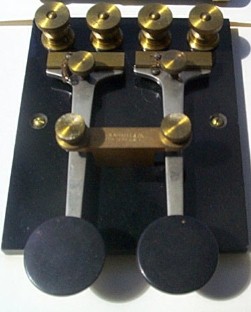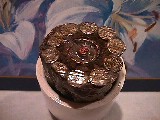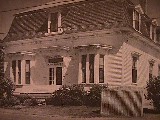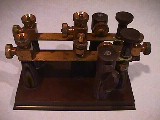(original) (raw)
Submarine Cable Telegraphy

Because of the length of submarine cable and its capacity to hold a large amount of charge, the ordinary Morse method of telegraphy was not practical. The received signals were too weak to be useful. This problem was overcome by keying the cable with an instrument with two telegraph keys on one base. When neither key is pressed down, they both rest against the upper brass strip and the cable is put directly to ground to drain off any residual charge. Due to the clever layout of the brass strips and key levers, if the "dit" contact is depressed (touch it with your mouse), the positive terminal of the battery is put to the ocean cable and a positive deflection occurs at the receiver. If the "dash" contact is depressed, the negative terminal of the battery is put to the submarine cable and a negative deflection occurs at the receiver. The receiver initially was a Mirror receiver, in which the deflection of a spot of light from a zero point on a screen up or down meant dot or dash and was recorded by a clerk. The duration of the deflection had no importance. Later, the Thomson Siphon Recorder was devised and an ink spot was continuously deposited on a recording tape for a permanent record of the message. Adapted from American Telegraphy & Encyclopedia of the Telegraph by William Maver, Jr.

J.H. Bunnell & Co. Atlantic Cable Telegraph Key
This key was used in the Montivideo, Uruguay office of American cables. It is circa 1910 and was acquired for the collection of D.K. DeNeuf on his visit to Montivideo in 1960. It was framed in a glass case the last 40 years it was in the DeNeuf collection, prior to its arrival here at The Sparks Telegraph Key Review. Other manufacturers made similar cable keys. A cable key consisting of two Steiner keys resides in the K5RW collection.

This is an example of a portion of submarine cable laid over 100 years ago to Havana, Cuba from the U.S. Similar cable, though heavier, was laid across the Atlantic Ocean. The larger outer wires of the cable provided strength and protection. The innermost wire carried the current. This cable was salvaged from the ocean floor by Tom Perera, W1TP.

The first transatlantic submarine telegraph cable was completed in 1858 and made landfall from Europe to North America in Newfoundland. Landline routes then carried the messages as necessary to America. The first direct transatlantic submarine telegraph cable from Europe to America made landfall at the Cable House in Rye, New Hampshire in 1874.

Many instruments were devised to aid in maintenance of long submarine cables. This is called a reversing key, one of many special instruments manufactured to help with testing of the submarine cables. Reversing keys were used to help eliminate interfering earth current effects when attempting to measure the resistance of a submarine cable. The two methods used, called "Quick Reversals" and "False Zero" are described in detail in the Signal Corps Manual No.3, 1916, Chapter 11, p. 39. Pictures of submarine test instruments are also shown there.
The first cable was successfully landed on the 6th of August, 1858, but the first public despatch, that of the Queen of England to the President of the United States, was not received until the 17th of August. The text of her message and his response can be seen below. This first cable only functioned for a short period of time.
.....from Prescott's
History, Theory and Practice of the Electric Telegraph, 1866.
 Back to the Index
Back to the Index